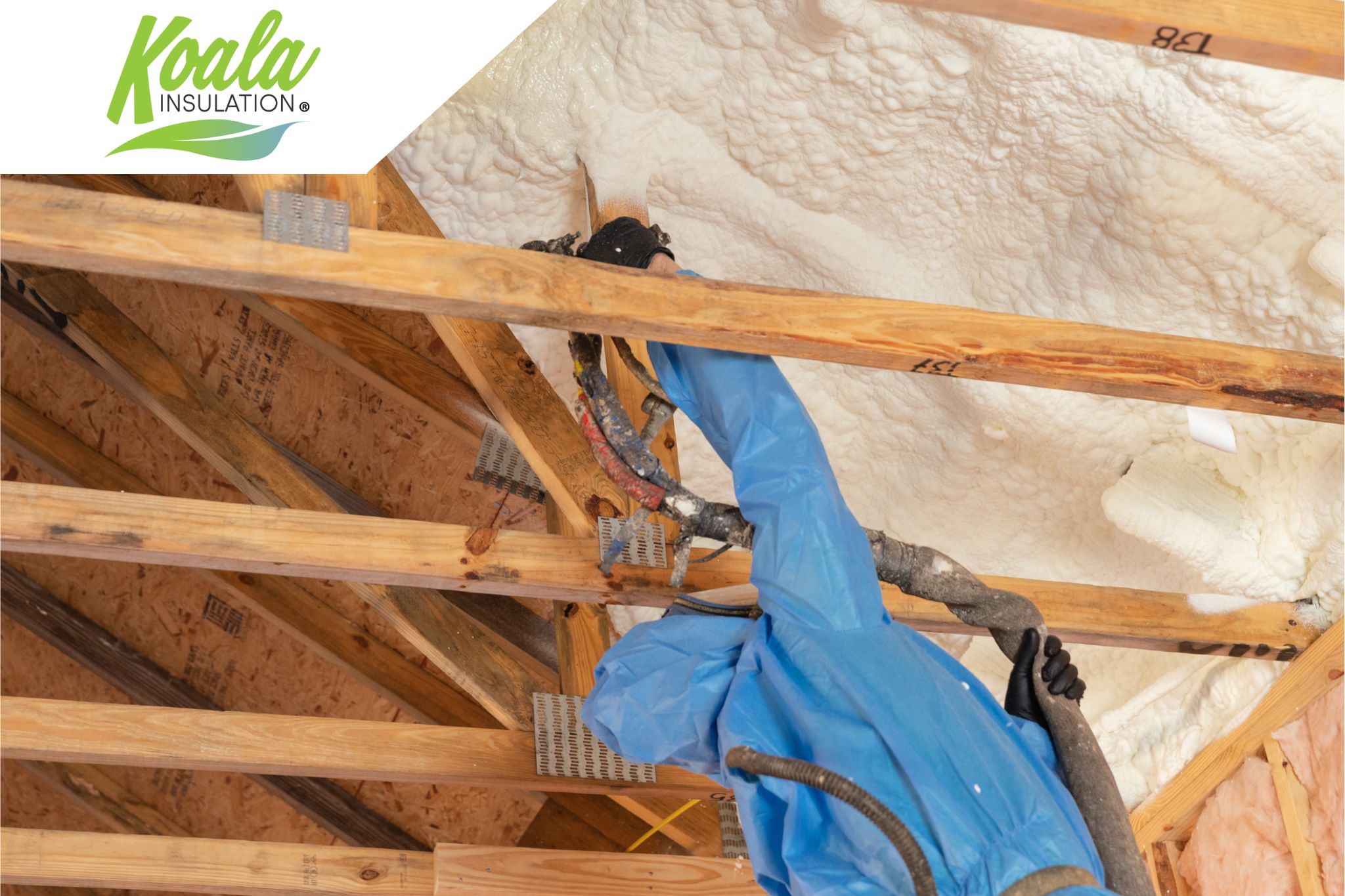Open-Cell and Closed-Cell Spray Foam: What’s the Difference?

Understanding Spray Foam Insulation
If you’re looking for a strong insulator that also acts as an effective air sealant, spray foam insulation is a great choice. This material is the result of a mixture of chemicals; for quality application, these are mixed on-site by a professional and sent through a hose into the stud cavity. When spray foam is applied to a surface, the chemicals react and harden to create a long-term barrier.
While there are spray foam varieties that come in a can for DIY use, for larger jobs, it takes industry equipment. In many states, industry-grade spray foam needs to be applied by a trained and certified technician. This ensures the individual is able to properly use the equipment and installs the correct mixture. A certified industry expert makes sure the chemicals are balanced and applied safely while also guaranteeing the expansion of the foam is set and dry because anyone enters the building without personal protective equipment (PPE).
Spray foam insulation can be applied on walls, in between ceiling joists, and even under floorboards. The two types of spray foam, closed-cell and open-cell, have their own benefits that can improve your environment based on the needs and requirements of your home. Closed-cell spray foam is rigid and dense, making it a popular choice for vapor barriers and structural support. On the other hand, open-cell spray foam is easily recognizable for its bubbly, cloud-like appearance and is most often used in warmer climates for its flexibility. As you’re weighing your options for the best material to have installed in your home, it’s important to consider the different strengths each material has to offer.
Closed-Cell Spray Foam
R-Value
The R-value, or resistance value, of insulation is the numerical measurement of a material’s effectiveness against heat transfer. With one of the highest R-values of your insulation options, closed-cell spray foam has an average of R-6.5 per inch of depth. A higher R-value generally means that less material needs to be used to effectively reduce the movement of heat in and out of a structure. This can help to reduce unwanted heat in the summer and trap in desired warmth throughout the winter.
Moisture Resistance & Vapor Barrier
While R-value is a significant factor to consider as you’re deciding between insulation materials, there are other benefits each has to offer. Closed-cell spray foam, in particular, is considered a quality vapor and moisture barrier. This helps to prevent condensation and water from causing damage to your structure. It also reduces the risk of increased humidity in a building, which creates the ideal environment for the growth of mold and bacteria.
Humidity and damp surfaces can also attract pests like termites, carpenter ants, and even dust mites. These insects can threaten the structural integrity and safety of your home. Pests and mold can also increase the risk of health hazards like respiratory irritation, allergies, and other illnesses.
Structural Support
One of the main features closed-cell spray foam is known for is the material’s rigidity and high density. This characteristic gives this type of insulation the ability to provide some support to the structural integrity of the building envelope. It provides strength to the surface it’s applied on as the spray foam is used inside walls, in between joists in the ceiling and floors, and even along the roof. While this is what makes closed-cell spray foam a common choice for industrial and commercial buildings, residential property can also significantly benefit from the additional assistance.
It’s important to keep in mind that there are several factors that can impact the effectiveness of your home’s insulation. While there are basic requirements from building codes and national suggestions, everything from your climate zone to even regular household habits can influence your choice of material. When you consult your local insulation professionals, they can provide more information on how closed-cell spray foam can contribute to the comfort, safety, and savings of your home.
Open-Cell Spray Foam
R-Value
Open-cell spray foam has about half of the closed-cell’s R-value, with an average of R-3.7 per inch of depth. Although this is significantly lower than its counterpart, this insulation material still has a higher R-value than most of the other materials that you’ll commonly find installed within residential buildings. Also, as the chemicals react when the material is being applied, your insulation technician can add more material to increase the R-value due to the thickness.
Sound Proofing
One advantage open-cell spray foam has over closed-cell is in noise reduction. This type of spray foam is more porous, making it a more effective sound barrier between the rooms or floors of your home. The hard and rigid structure that makes closed-cell spray foam exceptional for structural support can also make it weak at reducing noise. Because open-cell spray foam is less dense, this insulation is able to instead more effectively reflect the noise when applied throughout the house properly.
Some materials, like open-cell spray foam, can improve the sound suppression of a building by working as a barrier, similar to how they act as a barrier to heat transfer. The material slows the movement of waves or energy through a structure, which helps decrease the noise coming in from outside or other rooms.
Flexibility
Weighing on an average of about ½ pound per cubic foot, open-cell is the lighter of the two spray foam options. Because of the interconnected open cells within the foam, this type of spray foam insulation is typically more flexible than other materials. The flexibility of open-cell spray foam works great with seasonal expansion and contraction – as a homeowner, you may notice this as the house “settling” throughout the year. Being able to adjust to a building’s minor movement helps in preventing air leaks, which can become problematic even if they’re tiny openings and cracks within the building envelope.
Find The Right Team in Your Area
Both open-cell and closed-cell spray foam have a number of beneficial qualities. On top of being an effective defense against heat transfer, spray foam is also a quality sealant; when the material is applied to a surface, the foam expands and fills any gaps, cracks, or holes in the structure. This reduces air leaks and the entrance of outdoor allergens and pollutants. Understanding more about your insulation options can help you improve your environment by directly catering to the needs of your home.
With the right team of industry experts working with you and your household, you can find cost-effective and energy-efficient products and materials to lower your bills while improving comfort and safety. At Koala Insulation, our local teams offer free evaluations that break down the current condition of your home’s insulation and air sealing. This way, you can make informed decisions with the help of insulation professionals while also taking into account your current schedule and budget. Contact your local Koala Insulation team today and schedule your free evaluation to learn more about how updated insulation and air sealing can impact your environment.
Find Your Location


Get a quote



